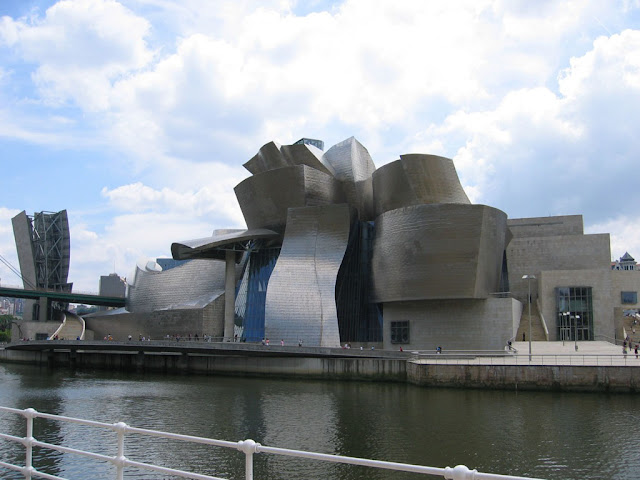by architect Vangelis Saitis
Frank Gehry
Undisputed superstar of modern architecture, the F. Gehry designs quirky and unusual daring buildings soon become tourist attractions. A typical example is the Guggenheim Museum in Bilbao, Spain thwarts any conventional understanding of the shape of a building. Looking like a giant, expressionist, modern sculpture has a curved, titanium metal blocks that seem to move defying the laws of static and gravity. The subversive design can be understood and interpreted by the criteria of modern architecture. Indeed it seems that shatters the principles of modernism, as the interaction of form and function (form follows function), the emphasis on removal (less is more) and the belief in universal values.
An office building designed in Prague became known to the public under the name "Fred & Ginger" and like to dance like the famous Hollywood couple. The Disney Concert Hall in Los Angeles is a combination of curved shapes that provide a sense of tension and movement. An office complex in Düsseldorf, Germany exudes also an uncomfortable sense of tension and the carved blocks of buildings seem to twist, bend to be compressed or repelled by invisible forces.
Frank Gehry was born in 1929 in Toronto, Canada. His real name is Ephrain Owen Goldberg, that changed when he moved with his family in Los Angeles. He studied architecture at the University of South California and did graduate at Harvard. In the late 1960's showed a keen interest in modern sculpture, an attempt to unite art and architecture. For this purpose, worked closely with artists such as Claes Oldenburg and Richard Serra. The architecture of an acquired research, incorporating fragmentary experimental data using the method of collage. Extensively used industrial materials like galvanized, corrugated sheet metal, wire, particle board, etc. thus giving the buildings an image unstable, incomplete and improvised.
In early 1970, Gehry has developed an odd obsession for a pattern which took a central place in his artistic pursuits. This one; fish! In an ironic mood stated that instead of columns, capitals and pediments of classicism, rather inspired by the fish, one of the oldest life forms on earth. Studying and designing the ongoing movement and developed a form of abstract morphological vocabulary. His experiments led him Gehry in a style called Deconstruction, ie "deconstruction." This method encompasses the "deconstruction" of a building into separate components, which are then synthesized together like a puzzle or a collage.
The composition creates an unstable, chaotic set that conveys an intensity and a dynamic motion. Because of the curved shapes, Gehry's buildings refer to organic architecture without, however, to follow the overall logic and concept design. The designs using three-dimensional models. The plans made by computer modeling a complex, metallic, static entity. Projects few decades ago it seemed utopian and impractical remained on paper, can now be achieved thanks to the technological capabilities of the season. Something is clearly demonstrated in ingenious, peculiar, unpredictable and inventive architecture of Frank Gehry.
Frank Gehry
| photo by ©Thomas Mayer |
An office building designed in Prague became known to the public under the name "Fred & Ginger" and like to dance like the famous Hollywood couple. The Disney Concert Hall in Los Angeles is a combination of curved shapes that provide a sense of tension and movement. An office complex in Düsseldorf, Germany exudes also an uncomfortable sense of tension and the carved blocks of buildings seem to twist, bend to be compressed or repelled by invisible forces.
Frank Gehry was born in 1929 in Toronto, Canada. His real name is Ephrain Owen Goldberg, that changed when he moved with his family in Los Angeles. He studied architecture at the University of South California and did graduate at Harvard. In the late 1960's showed a keen interest in modern sculpture, an attempt to unite art and architecture. For this purpose, worked closely with artists such as Claes Oldenburg and Richard Serra. The architecture of an acquired research, incorporating fragmentary experimental data using the method of collage. Extensively used industrial materials like galvanized, corrugated sheet metal, wire, particle board, etc. thus giving the buildings an image unstable, incomplete and improvised.
In early 1970, Gehry has developed an odd obsession for a pattern which took a central place in his artistic pursuits. This one; fish! In an ironic mood stated that instead of columns, capitals and pediments of classicism, rather inspired by the fish, one of the oldest life forms on earth. Studying and designing the ongoing movement and developed a form of abstract morphological vocabulary. His experiments led him Gehry in a style called Deconstruction, ie "deconstruction." This method encompasses the "deconstruction" of a building into separate components, which are then synthesized together like a puzzle or a collage.
The composition creates an unstable, chaotic set that conveys an intensity and a dynamic motion. Because of the curved shapes, Gehry's buildings refer to organic architecture without, however, to follow the overall logic and concept design. The designs using three-dimensional models. The plans made by computer modeling a complex, metallic, static entity. Projects few decades ago it seemed utopian and impractical remained on paper, can now be achieved thanks to the technological capabilities of the season. Something is clearly demonstrated in ingenious, peculiar, unpredictable and inventive architecture of Frank Gehry.
| The Disney Concert Hall in Los Angeles |


